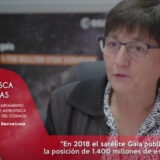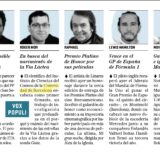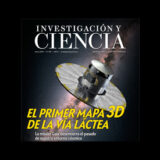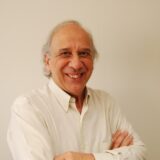Francesca Figueras talks about Gaia mission (RNE, 9/11/2019)
Francesca Figueras talks about Gaia mission at radio programme Sapiens. Full info at http://www.rtve.es/alacarta/audios/sapiens/sapiens-del-paleolitico-supermercado-09-11-19/5438492/ Hace 500 años creíamos que la Tierra era el centro del Universo, ahora sabemos que es un planeta más, de un sistema más de una Galaxia más. El conocimiento nos hace cada vez más pequeños pero a la vez la investigación científica nos hace más grandes. Hoy nos acompaña la astrofísica Francesca Figueras, Presidenta de la Asociación de Astronomía y miembro del equipo de científicos de la misión europea GAIA. En...
read moreGaia starts mapping the galactic bar in the Milky Way (Notícies UB, 16/07/2019)
Gaia starts mapping the galactic bar in the Milky Way (Notícies UB) The first direct measurement of the bar-shaped collection of stars at the centre of our Milky Way galaxy has been made by combining data from the Gaia mission (European Space Agency, ESA) with complementary observations by ground- and space-based telescopes. The study, published in Astronomy & Astrophysics, was led by researchers from the Institute of Science Cosmos of the University of Barcelona and from the Leibniz Institute for Astrophysics Potsdam (Germany). The second release of data from Gaia star-mapping...
read moreRoger Mor: En busca del nacimiento de la Vía Láctea (El Mundo, 13/05/2019)
ROGER MOR En busca del nacimiento de la Vía Láctea (El Mundo) El científico del Instituto de Ciencias del Cosmos de la Universidad de Barcelona encabeza como primer firmante, un trabajo de investigación que profundiza en el porqué y cuándo del nacimiento de las estrellas de la Vía Láctea gracias a los datos de la sonda Gaia.
read moreThe article “El primer mapa 3D de la Vía Láctea” published in the Spanish version of Scientific American
By: C. Jordi, E. Masana Journal: Investigación y Ciencia, Nº 510, march 2019 Language: Spanish The article on the ESA’s Gaia space mission by Carme Jordi and Eduard Masana, researchers from the Barcelona Gaia team at the Institute of Cosmos Sciences UB, has been published on March in the journal Investigación y Ciencia. La misión Gaia, de la ESA, ha cartografiado con una precisión sin precedentes 1300 millones de estrellas de la galaxia. Sus resultados están cambiando la forma de ver y entender nuestro entorno cósmico. ¿Cómo se formó la Vía Láctea? ¿De dónde proceden las estrellas que...
read moreJordi Torra i Roca, Barcelona, 23/04/1949 – 26/02/2019
Ph.D. in Physics by the Universitat de Barcelona (1984) and Professor in the Department of Quantum Physics and Astrophysics in the same University, he focused his research career in the study of the structure, formation and evolution of our Galaxy, the Milky Way. He was one of the pioneers at European level in the development of the field of Astrometry from Space. In the 80s he accepted the challenge to lead the Spanish participation in the European Space Agency’s Hipparcos mission and, as a result from this work, Spain is fully participating in the Gaia mission, launched in 2013 and...
read more









